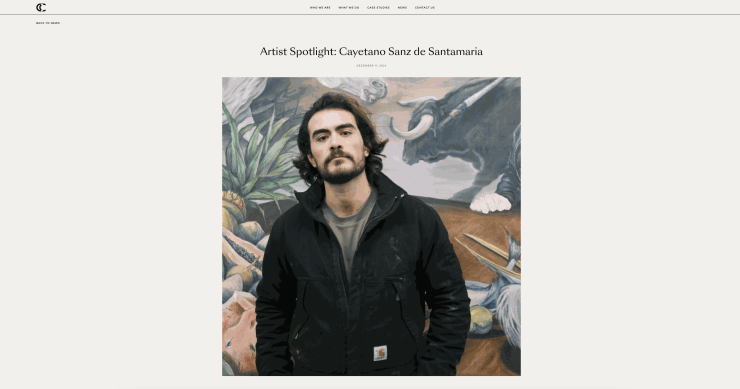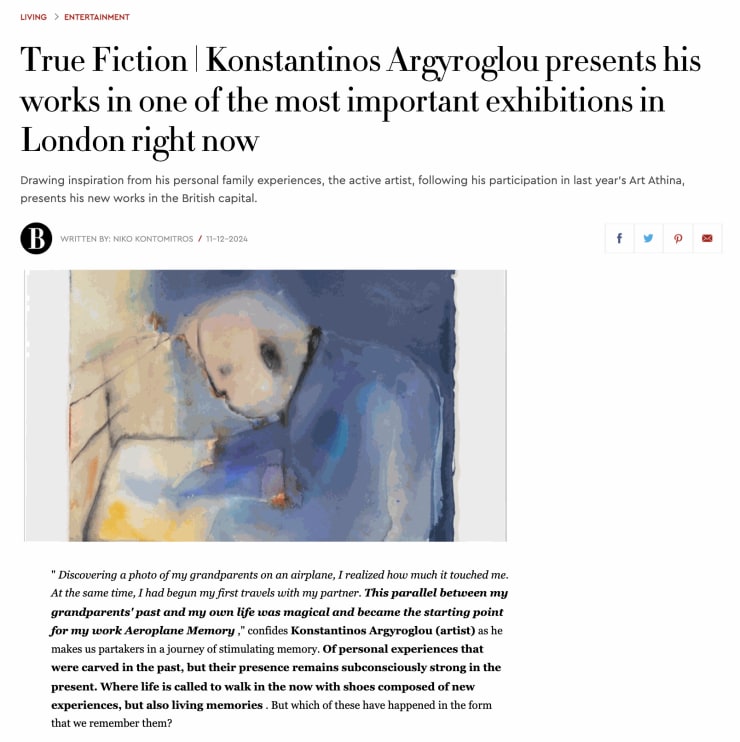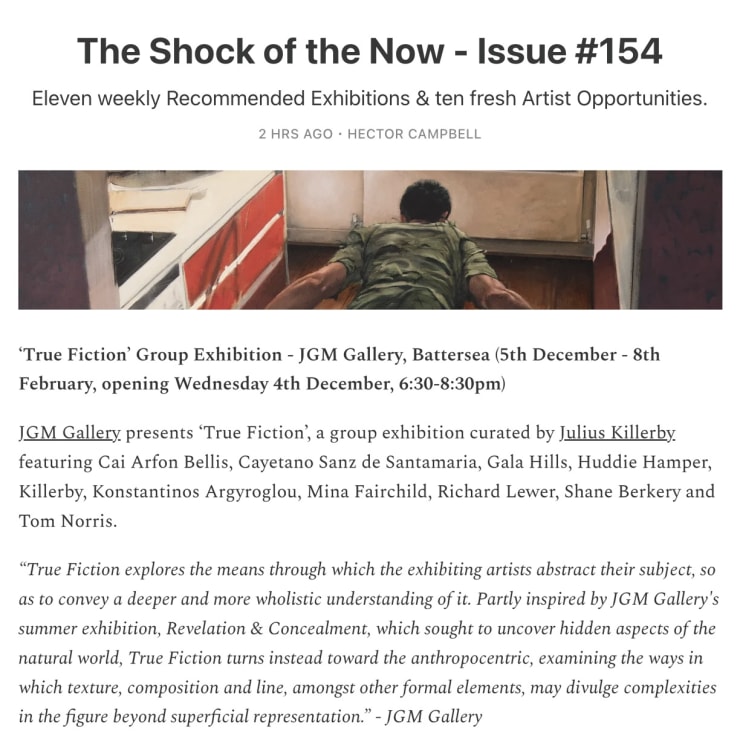True Fiction : An exhibition of works by ten figurative artists.
Past exhibition
Images
Overview
JGM Gallery presents True Fiction, an exhibition of works by ten figurative artists.
True Fiction explores the means through which the exhibiting artists abstract their subject, so as to convey a deeper and more wholistic understanding of it. Partly inspired by JGM Gallery's summer exhibition, Revelation & Concealment, which sought to uncover hidden aspects of the natural world, True Fiction turns instead toward the anthropocentric, examining the ways in which texture, composition and line, amongst other formal elements, may divulge complexities in the figure beyond superficial representation. It is the aim of this exhibition, as Francis Bacon once said, to “... trap appearance without making an illustration of it...” and to affirm this as one “... of the great excitements of being a figurative artist...” (Francis Bacon, in conversation with William Burroughs, 1982).
In his charcoal drawing, Pleasure Peak, and his heavily impastoed oil painting, Dance Dun, Cai Arfon Bellis depicts inner-city London raves. Often produced on location, and in the midst of this communal commotion, Bellis blends exceptional draughtsmanship with the spontaneous interactions he has with those around him. Bellis translates accidental collisions or the spillage of someone's drink into figurative abstractions, which he uses to emphasise or blur the individuality of his subject, and to capture the dynamism of the event.
The degree to which Shane Berkery deviates from realism is in many ways analogous to the indistinctness of memory. It is in the ways we embellish or forget aspects of our personal narrative that Berkery believes the most compelling imagery is to be found. In Induced Levitation the detailed rendering of certain objects, such as a toaster and pot lodged on the kitchenette bench, dissipate into preliminary outlines and sketches. Proportions are skewed and certain objects take compositional precedence over others. Paradoxically, this style of representation, though less than factually accurate, feels more vivid, for it mimics the ways in which the viewer might recall events from their own life. Moreover, the positioning of the figure − face down and suspended inches from the floor − charges this piece with the supernatural, and the omission of the subject's face induces a subtle trepidation in the viewer.
Memory and the way it can, within the mind's eye, intensify or distort past events, is also a key aspect of Konstantinos Argyroglou's largely autobiographical work. Painted with a pseudo-naivety, Aeroplane Memory, Beyond Myself and Grandpa's Easter Dinner possess a tender aesthetic that is consistent with their representation of moments from the artist's childhood. Blotched watercolour markings often contrast with hard-edged forms, such variations in the application of paint reminiscent of a domestic arts practice or the world viewed through a child's gaze. As with Berkery's work, there is a correlation between this style of figuration and the vagueness of memory.
The Tempest, a ceramic vessel depicting figures within a landscape, marks a significant stylistic progression for Tom Norris, wherein he combines the expressive mark-making that defined much of his earlier work with a newly adopted collage process. The collaged sections, often cut from photographs, are representational, however, as fragments they deny the viewer a complete impression of the original image. They thus appear like windows amongst the forested landscape which dominates much of the vessel's remaining surface area. Their disconnection from each other and from the rest of the gesturally rendered composition, establishes them more as formal, rather than representational, components of the work. In this way, Norris prioritises an overall harmonious aesthetic, rather than an image that invites narrative rationalisation.
Titling her photographs with haikus − Circles In The Sand, Mirror The Spiralling Feet and In The Clouds Above − Mina Fairchild takes inspiration from a Japanese poetic tradition which emphasises simplicity, intensity and directness of expression. These images of a figure in a landscape, enveloped within a tempestuous fan of silk, achieve this and more. The subject's outline takes on an auratic quality and she almost blends into the landscape around her. This is in many ways consistent with haiku poetry, which predominantly addresses the natural world and our connection to it. In an interesting inversion of this tradition, however, Fairchild presents these images in a distinctly industrial guise: black and white film photography on sheets of aluminium. In this there is an intriguing contrast between form and content.
In Simius, Gala Hills sublimates her childhood remembrances and daydreams into an idealised, imagined world. Ostensibly perturbing aspects of the image − the approach of a bear, a spectral squirrel monkey, or the voyeuristic gaze of a male figure − are offset by Hills' feathered brushstrokes and scumbling, as well as the optimistic palette of light greens, blues and pinks. That is, danger is presented to the audience, but through Hills' style of figuration, in a tongue and cheek way. The composition recalls Diego Velazquez' Las Meninas, wherein the Infanta Margarita is dotingly attended to by members of the Spanish court, as she herself breaks the fourth wall, staring out toward the viewer. In Simius, this eye contact with the central figure − perhaps representative of the artist as a young girl − establishes her as the mediator between the real and the unreal, the pictorial logic of this monumental canvas and the world inhabited by its audience.
By covering his subject's head in Social Fabric I, Julius Killerby makes an abstraction of the face, but one which corresponds with his sitter's facial features. In this way, he balances the anonymity of the subject with a representational depiction of them. This anonymity, moreover, universalises the figure, perhaps prompting the viewer to put themself in the subject's shoes. People pushed to painful extremes feature in much of Killerby's recent work. Explorations of this theme are intended to capture that which he believes to be most distinct about humanity − the capacity to transcend suffering and instinct through abstract thought. Though apparently secular images, these works are thus informed by Christian iconography and depictions of martyrdom. The compositional conventions of these traditions − that of a pyramidal structure, imbued with a sense of ascension − are also utilised in Self Portrait, in which the artist's visage is blurred, capturing him in a moment of heightened sensation. The shadow − conspicuously static in comparison to the animated figure that casts it − serves as a poignant reminder of the dualities inherent in human existence, and the states of being we have the capacity to experience and transcend.
Cayetano Sanz de Santamaria's work, First Fruits For The Son Of Bachué, is dominated by the side profile of a colossal Brahman bull, which the artist deifies as the son of Bachué, a Goddess in Muisca mythology. Originating from the Altiplano Cundiboyacense, a high altitude plain in modern day Colombia, the story of Bachué's son describes a virile being which, prior to procreating, was nourished with the first fruits of the season. Through Santamaria's lens, the story takes on an especially eerie quality. Upon an Arcadian grassland, three emaciated figures tend to the bull, two of them bearing fruit, the other caressing his side in a gesture that seems to both glorify and objectify the beast. Through their ritualistic masks, the eyes of these skeletal caretakers appear dumbfounded, a distinct contrast with the dignified and penetrating gaze of the bull, literally God-like by comparison. As with Gala Hills' work, eye contact with the viewer establishes the bull as the painting's focal point, and the preeminent character in this magical realist imagining.
Creatures of the earth, often on the brink of maturation, are a recurring subject for Huddie Hamper, a painter and printmaker from Chatham, Kent. We find these animals in transitory moments, often alluded to by their surroundings as much as their physical form. In White Deer, Hamper depicts a deer encountered at night in a landscape so flat and vast as to see the earth's curvature in it. Bioluminescence exudes from Hamper's subject, its liminality further underscored by a slight contrapposto stance and the image of a younger deer behind. He thereby emphasises the impermanent nature of the representation before us, and in his luminous and vaporous style, finds an analogue for the inevitable passage through stages of growth, change and, by implication, inevitable decline. Parallels are found with Hills and Santamaria's animalian dreamscapes, where archetypal figures are not presented as stringent icons, but are ambiguous and encourage multiple readings.
Richard Lewer's 14 October 2023 presents a poignant scene, featuring a solitary figure in a central Australian landscape, accompanied by three dogs. Produced in the context of the 'No' vote to Australia's Voice referendum, which the artwork's title explicitly references, Lewer's painting on brass is imbued with melancholy and pathos. The despondent central figure departs from the foreground, her turned back creating separation from the viewer, which thus suggests her alienation from Australia's political body. She instead withdraws into a vibrant landscape, the energy of which is enhanced by the sheen of the underlying brass. That is, Lewer uses this landscape as a metaphor for the figure's connection to the natural world, a symbolic approach to painting that is very much consistent with the spirit of Indigenous contemporary art. Inspired by several journeys made by the artist into East Pilbara and Gunbalunya in East Arnhem Land, alongside members of the Parnngurr community, 14 October 2023 is an archetypal example of Lewer's practice, wherein he frequently combines personal narrative with broader societal implications.
True Fiction ultimately addresses the rich terrain between abstraction and representation, demonstrating the ways in which the exhibiting artists, through their deviations from literal depiction, convey ideas relating to memory, psychology, perception, time and politics, amongst a variety of other themes. In these figurative abstractions, the audience is offered equivalents for the uncertainties and mysteries of life, through which a more immersive and authentic connection to the world around us might be possible.
Exhibiting artists: Cai Arfon Bellis, Cayetano Sanz de Santamaria, Gala Hills, Huddie Hamper, Julius Killerby, Konstantinos Argyroglou, Mina Fairchild, Richard Lewer, Shane Berkery and Tom Norris.
For further information and press enquiries, please contact the gallery at info@jgmgallery.com or + 44 (0) 207 228 6027.
Opening Reception:
4 December 2024, 6:30pm to 8:30pm
24 Howie Street,
London SW11 4AY
Selected Works
-
 Shane BerkeryInduced Levitation, 2024Oil on canvas152cm x 122cm
Shane BerkeryInduced Levitation, 2024Oil on canvas152cm x 122cm -
 Cayetano Sanz de SantamariaFirst Fruits For The Son Of Bachué, 2024Oil on canvas80cm x 110cm
Cayetano Sanz de SantamariaFirst Fruits For The Son Of Bachué, 2024Oil on canvas80cm x 110cm -
 Mina FairchildIn The Clouds Above, 202335mm, direct print on brushed aluminium (Ed. of 10)20cm x 29.5cm
Mina FairchildIn The Clouds Above, 202335mm, direct print on brushed aluminium (Ed. of 10)20cm x 29.5cm -
 Gala HillsSimius, 2024Oil on calico canvas137cm x 254cm
Gala HillsSimius, 2024Oil on calico canvas137cm x 254cm -
 Konstantinos ArgyroglouAeroplane Memory, Beyond Myself, 2023Oil and watercolour on canvas80cm x 110cm
Konstantinos ArgyroglouAeroplane Memory, Beyond Myself, 2023Oil and watercolour on canvas80cm x 110cm -
 Huddie HamperWhite Deer, 2024Oil on canvas150cm x 120cm
Huddie HamperWhite Deer, 2024Oil on canvas150cm x 120cm -
 Cai Arfon BellisPleasure Peak, 2024Charcoal on paper105cm x 125cm
Cai Arfon BellisPleasure Peak, 2024Charcoal on paper105cm x 125cm -
 Julius KillerbyStretch, 2023Oil on canvas35cm x 20cm
Julius KillerbyStretch, 2023Oil on canvas35cm x 20cm -
 Richard Lewer14 October 2023, 2023Acrylic on brass65cm x 64cm
Richard Lewer14 October 2023, 2023Acrylic on brass65cm x 64cm -
 Tom Norris, The Tempest, 2024
Tom Norris, The Tempest, 2024
Press
-

Cultural Communications
Artist Spotlight: Cayetano Sanz de SantamariaDecember 11, 2024 -

Harper's Bazaar
"True Fiction | Konstantinos Argyroglou presents his works in one of the most important exhibitions in London right now"Niko Kontomitros, December 11, 2024 -

The Shock Of The Now - Issue #154
'True Fiction' featured in eleven weekly Recommended ExhibitionsHector Campbell, December 4, 2024










